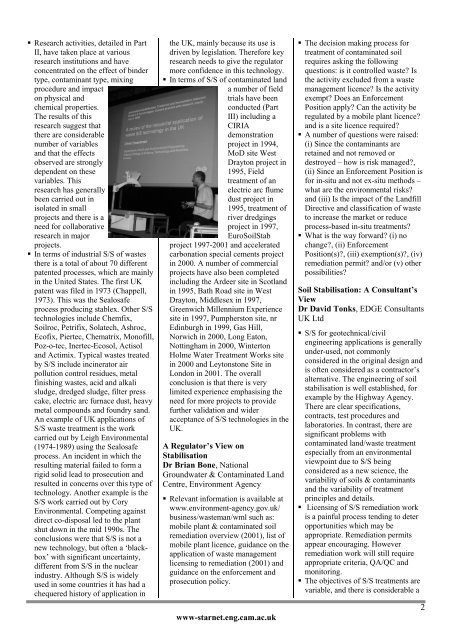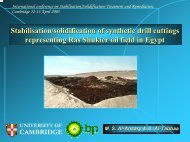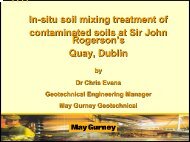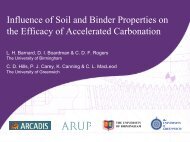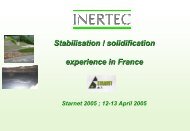here - Starnet - University of Cambridge
here - Starnet - University of Cambridge
here - Starnet - University of Cambridge
- No tags were found...
Create successful ePaper yourself
Turn your PDF publications into a flip-book with our unique Google optimized e-Paper software.
Research activities, detailed in PartII, have taken place at variousresearch institutions and haveconcentrated on the effect <strong>of</strong> bindertype, contaminant type, mixingprocedure and impacton physical andchemical properties.The results <strong>of</strong> thisresearch suggest thatt<strong>here</strong> are considerablenumber <strong>of</strong> variablesand that the effectsobserved are stronglydependent on thesevariables. Thisresearch has generallybeen carried out inisolated in smallprojects and t<strong>here</strong> is aneed for collaborativeresearch in majorprojects.In terms <strong>of</strong> industrial S/S <strong>of</strong> wastest<strong>here</strong> is a total <strong>of</strong> about 70 differentpatented processes, which are mainlyin the United States. The first UKpatent was filed in 1973 (Chappell,1973). This was the Sealosafeprocess producing stablex. Other S/Stechnologies include Chemfix,Soilroc, Petrifix, Solatech, Ashroc,Ec<strong>of</strong>ix, Piertec, Chematrix, Mon<strong>of</strong>ill,Poz-o-tec, Inertec-Ecosol, Actisoland Actimix. Typical wastes treatedby S/S include incinerator airpollution control residues, metalfinishing wastes, acid and alkalisludge, dredged sludge, filter presscake, electric arc furnace dust, heavymetal compounds and foundry sand.An example <strong>of</strong> UK applications <strong>of</strong>S/S waste treatment is the workcarried out by Leigh Environmental(1974-1989) using the Sealosafeprocess. An incident in which t<strong>here</strong>sulting material failed to form arigid solid lead to prosecution andresulted in concerns over this type <strong>of</strong>technology. Another example is theS/S work carried out by CoryEnvironmental. Competing againstdirect co-disposal led to the plantshut down in the mid 1990s. Theconclusions were that S/S is not anew technology, but <strong>of</strong>ten a ‘blackbox’with significant uncertainty,different from S/S in the nuclearindustry. Although S/S is widelyused in some countries it has had achequered history <strong>of</strong> application inthe UK, mainly because its use isdriven by legislation. T<strong>here</strong>fore keyresearch needs to give the regulatormore confidence in this technology.In terms <strong>of</strong> S/S <strong>of</strong> contaminated landa number <strong>of</strong> fieldtrials have beenconducted (PartIII) including aCIRIAdemonstrationproject in 1994,MoD site WestDrayton project in1995, Fieldtreatment <strong>of</strong> anelectric arc flumedust project in1995, treatment <strong>of</strong>river dredgingsproject in 1997,EuroSoilStabproject 1997-2001 and acceleratedcarbonation special cements projectin 2000. A number <strong>of</strong> commercialprojects have also been completedincluding the Ardeer site in Scotlandin 1995, Bath Road site in WestDrayton, Middlesex in 1997,Greenwich Millennium Experiencesite in 1997, Pumpherston site, nrEdinburgh in 1999, Gas Hill,Norwich in 2000, Long Eaton,Nottingham in 2000, WintertonHolme Water Treatment Works sitein 2000 and Leytonstone Site inLondon in 2001. The overallconclusion is that t<strong>here</strong> is verylimited experience emphasising theneed for more projects to providefurther validation and wideracceptance <strong>of</strong> S/S technologies in theUK.A Regulator’s View onStabilisationDr Brian Bone, NationalGroundwater & Contaminated LandCentre, Environment AgencyRelevant information is available atwww.environment-agency.gov.uk/business/wasteman/wml such as:mobile plant & contaminated soilremediation overview (2001), list <strong>of</strong>mobile plant licence, guidance on theapplication <strong>of</strong> waste managementlicensing to remediation (2001) andguidance on the enforcement andprosecution policy.www-starnet.eng.cam.ac.ukThe decision making process fortreatment <strong>of</strong> contaminated soilrequires asking the followingquestions: is it controlled waste? Isthe activity excluded from a wastemanagement licence? Is the activityexempt? Does an EnforcementPosition apply? Can the activity beregulated by a mobile plant licence?and is a site licence required?A number <strong>of</strong> questions were raised:(i) Since the contaminants areretained and not removed ordestroyed – how is risk managed?,(ii) Since an Enforcement Position isfor in-situ and not ex-situ methods –what are the environmental risks?and (iii) Is the impact <strong>of</strong> the LandfillDirective and classification <strong>of</strong> wasteto increase the market or reduceprocess-based in-situ treatments?What is the way forward? (i) nochange?, (ii) EnforcementPosition(s)?, (iii) exemption(s)?, (iv)remediation permit? and/or (v) otherpossibilities?Soil Stabilisation: A Consultant’sViewDr David Tonks, EDGE ConsultantsUK LtdS/S for geotechnical/civilengineering applications is generallyunder-used, not commonlyconsidered in the original design andis <strong>of</strong>ten considered as a contractor’salternative. The engineering <strong>of</strong> soilstabilisation is well established, forexample by the Highway Agency.T<strong>here</strong> are clear specifications,contracts, test procedures andlaboratories. In contrast, t<strong>here</strong> aresignificant problems withcontaminated land/waste treatmentespecially from an environmentalviewpoint due to S/S beingconsidered as a new science, thevariability <strong>of</strong> soils & contaminantsand the variability <strong>of</strong> treatmentprinciples and details.Licensing <strong>of</strong> S/S remediation workis a painful process tending to deteropportunities which may beappropriate. Remediation permitsappear encouraging. Howeverremediation work will still requireappropriate criteria, QA/QC andmonitoring.The objectives <strong>of</strong> S/S treatments arevariable, and t<strong>here</strong> is considerable a2


